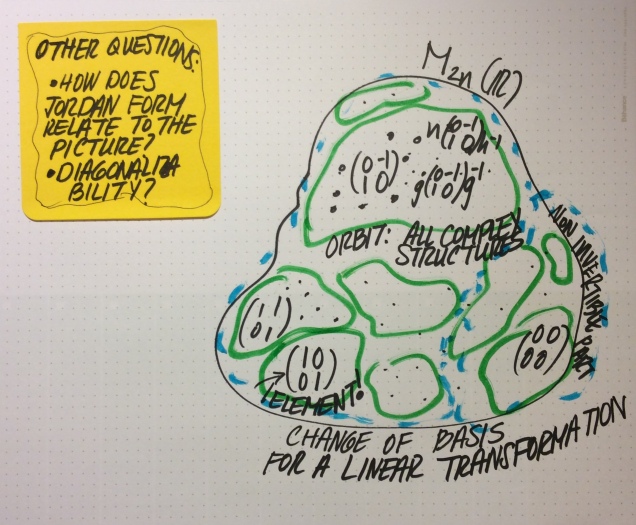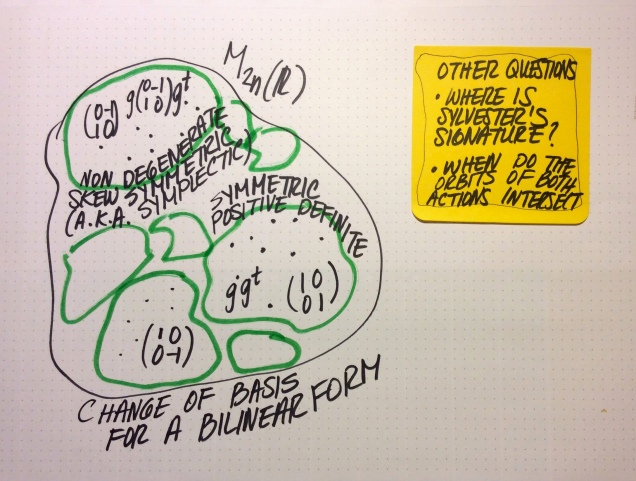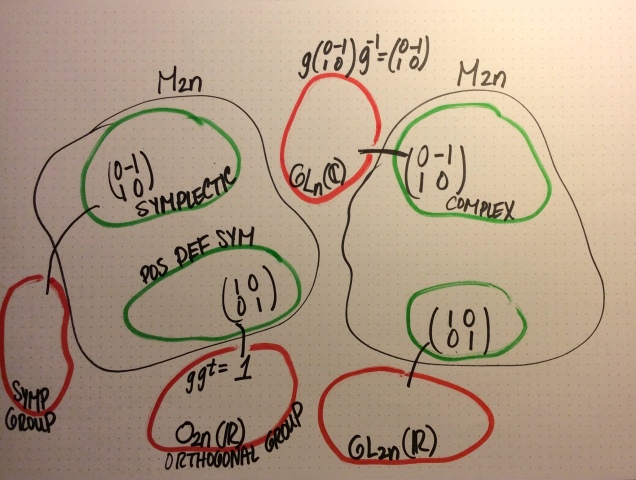An Overview
Before you is a short story about the group of invertible matrices and 2 of its interactions with the vector space of all matrices.
The main characters of our story are the general linear group of invertible n by n matrices, , and the vector space of all n by n matrices (not necessarily invertible),
.
We will see change of Basis actions in 2 different contexts and witness the drama that unfolds in the orbits and the stabilizers of these actions.
Specifically, when we restrict our attention to even dimensional vector spaces, we will see that in the orbits and stabilizers of 2 special elements, we find the building blocks of the linear symplectic story. These are the orthogonal group , the symplectic group
, complex structures, positive definite symmetric bilinear forms, and non-degenerate skew symmetric (a.k.a. symplectic) forms.
The gist of the story can be found in this video (best viewed on a big, full screen).
The 2 Actions
The group , of real invertible n by n matrices, acts on
, the vector space of all real matrices, in 2 ways that show up in varied mathematical settings. The pictures that I had in my mind for these 2 actions provided a simple framework with which to organize some of the information I came across as I was learning about linear symplectic things from the book Introduction to Symplectic Topology. This framework is beautiful, so I like to share it, and a great way to do this is by showing the pictures.
The 2 actions I will talk about can be described in several different ways, among them is this one
- Change of basis for a linear transformation
- Change of basis for a bilinear form
Take an element g in and an element m in
.
- Under the first action,
- Under the second action,
The Orbits
Whenever a group acts on a set, the action partitions the set into orbits, and each orbit can be viewed as an equivalence class of the equivalence relation that is created by the partition.
Let’s look at the orbits of the first action
If you happen to be a matrix m, and you meet an element of g that insists on multiplying you on the left by itself and on the right by its inverse, what happens to you? Well… it depends on which matrix m you happen to be.
If you are the matrix (of any dimension), you are not easily impressed by invertible matrices showing up and multiplying you from all directions, and so you stay just as you were. Your orbit contains you and only you. In fact, if you are any scalar multiple of the identity matrix, you are guaranteed an orbit of your own, but if are not a scalar multiple of the identity you will have to share your orbit with other matrices.
In the language of linear algebra, the orbit of the matrix m under this action is the set of all matrices that are similar to it. Two matrices m and p are similar, , if and only if they represent the same linear transformation with respect to different bases.
If we are dealing with an element g in and a matrix m in
, and this is what I will be assuming from now on, one of the orbits will contain the matrix
. This matrix
squares to
and, in fact, the orbit is composed of all other matrices that have the same property.
Another name for this orbit is the set of all complex structures on . These matrices are so named, because multiplication with each of them turns an even dimensional real vector space into a complex vector space (of half the dimension) by functioning like multiplication by the scalar i.

The orbits of this action house other interesting treasures, but now we turn out attention to the orbits of the second action,
In this case, what the general linear group is doing is changing basis for bilinear forms (some might like to think of this as the pullback of such forms).
The matrix is now sharing its orbit with a lot of matrices! To have the honor of being in the orbit with the identity, a matrix m, must have the property that we could somehow get to it through the identity, i.e.
. We can play with the transpose, and we will find out that all the matrices in this orbit are symmetric, and additional fiddling will show us that they are also positive definite. Change of basis for a bilinear form gets us from the identity to all the other positive definite symmetric bilinear forms.
In general, symmetry is preserved by this action, for if then
.
Let’s look at the orbit of our other matrix of interest, . We notice that this matrix is skew-symmetric — taking its transpose is equivalent to multiplying it by -1, and this is again a condition that is necessary and sufficient for being in its orbit.
This action also preserves the non-degeneracy (or degeneracy) of a form, and therefore the orbit of the matrix is the set of non-degenerate, skew symmetric bilinear forms on
. These are also known as the symplectic forms.

And so, from simply looking at the orbits of these 2 actions, we have uncovered all complex structures on , the positive definite symmetric bilinear forms, the non-degenerate skew symmetric (a.k.a. symplectic) forms, and the set of matrices that commute with all invertible matrices, the scalar multiples of the identity matrix.
Even more awaits us, once we start fishing around in…
The Stabilizers
For variety, we’ll start with the stabilizers of the second action, , also known as change of basis for a bilinear form.
First, we will ask: Who stabilizes the identity? In other words, we would like to know for which matrices g does . The answer is the group of all orthogonal matrices
, the length preserving linear transformations, isometries of
with this positive definite symmetric bilinear form.
The symplectic group shows up as the stabilizer of the non-degenerate skew symmetric form
. Its elements are all the matrices for which
, those that preserve area.

Examining the stabilizers of these 2 elements in the action, , we find that the entire group stabilizes the identity. We already knew that, as this is the flip side of being a fixed point of the action, i.e. a one element orbit.
And who might stabilize ? Here is a nice interpretation: First, we have noticed that the entire general linear group stabilizes the identity, as well as all the scalar multiples of the identity. In essence, we are seeing that these matrices are a copy of
that
commutes with. The group sees these matrices as scalars.
When we are looking for the stabilizer of (and of its scalar multiples), we are asking this matrix, “which group is going to treat you as a scalar?” Since this matrix turns a real vector space into a complex vector space of half its dimension by functioning as the number i would, it is particularly satisfying to see that its stabilizer group is a copy of
that sits inside
.
The Rest of the Story
By following the group of invertible matrices and the vector space of matrices as they interact in 2 change of basis actions, we have managed to uncover key linear symplectic elements.
There is also a beautiful story to be told about the compatibility of complex structures, positive definite symmetric bilinear forms, and non-degenerate skew symmetric forms (a.k.a. symplectic).
The vantage point these 2 actions provide nicely frames other parts of the mathematical landscape. I invite you to explore each action individually or, as I like to relate to them, in juxtaposition and partnership.
Thanks a lot to Anna and Rachael for creating a place that inspired me to post my pictures and words. This is my first ever math blog post. Find info about my other activity here.
Introduction to Symplectic Topology was written by Dusa McDuff and Dietmar Salamon. Chapter 2 talks about linear symplectic things.